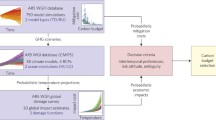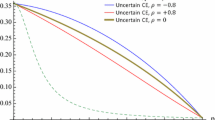Abstract
The IPCC’s fifth assessment report of Working Group III has just come out. It pays special attention to the 2 °C temperature target and tells us that the window of opportunity to prevent such climate change is rapidly closing. Yet, the report also presents a portfolio of stabilization targets, reflecting a fundamental ambiguity: there is no unique “dangerous” climate threshold. Here, we describe a framework for the evaluation of optimal climate policy given an uncertain formal climate threshold. We find that uncertainty leads to moving targets: even when the available information does not change, future regulators will tend to relax current climate plans.
We develop a reduced form integrated assessment model to assess the quantitative significance of our findings. We calibrate preferences such that in 2000 a stabilization target of 450 ppmv maintains the optimal balance between climate risks and abatement costs. The naïve equilibrium ultimately reaches a peak of 570 ppmv, missing the 2000 stabilizations targets by a wide margin. Our results offer an explanation for the inertia in mitigation efforts over the past decades: policies often delay the majority of abatement efforts. Yet, believing that subsequent regulators will uphold the planned future efforts is self-defeating.




Similar content being viewed by others
Notes
The IPCC writes “Delaying mitigation efforts beyond those in place today … narrow[s] the range of options consistent with maintaining temperature change below 2 °C relative to pre-industrial levels (high confidence).” (Edenhofer et al. 2014) Reading the details of the report, it becomes clear that various assessment models suggest we will quickly run out of options, and some models consider the 2 °C already out of reach.
The notion of time-inconsistent policy has a long tradition in fiscal (Kydland and Prescott 1980; Tesfatsion 1986), monetary (Calvo 1978) and environmental (Karp and Newbery 1993) economics. In this literature, policy makers are tempted to announce specific future policies as a mechanism to direct current behaviour of individual agents (who have time-consistent preferences). For example, a regulator may introduce fiscal incentives to increase foreign direct investment, but then may be tempted to save costs by discontinuing the fiscal incentives after the investments are sunk. Private agents in turn anticipate that policies can change and demand credible commitment. The time-inconsistency problem we study in this paper is different in nature. It does not arise from a strategic interaction between a regulator and individual agents, but stems from time-inconsistent preferences as such. Specifically, we do not distinguish between the regulator and the individual agent, and we do not consider a decentralization problem. The problem we study is better comparable to the multi-self time-consistency problem, as studied by e.g., Laibson (1997), but extended to the level of aggregate preferences and social planning.
Tsur and Zemel (1996) show that in a simplified version of our model, the stock of emissions is non-decreasing along the optimal path.
Conceptually, the welfare function is also linked to Chichilnisky’s (1996) ideas of non-dictatorship of the present and future. The welfare function can represent the idea that at each point in time, generations care for their own and near descendants economic welfare, as captured by the first part, but they also care, additionally, for the consequences of their actions in the very long run. For example, people may value the current and the future continued existence of ecosystems, complementary to their valuation of the consumption stream.
If concentrations fall below a level that has been achieved in the past, this will likely be the result of technological change that also makes it unattractive economically to return to the previous concentration peak. Notwithstanding, the regulator could do so without increasing the catastrophe probability.
Convexity follows from decreasing returns to scale in production and utility. The condition applies in most IAMs. The set will be smooth as long as the atmospheric concentration increases. See footnote 10 for a discussion of what happens when concentrations become stationary.
We thank an anonymous referee for this formulation.
Note that the MRT < 0, as it trades off a good (U) with a ‘bad’ (Λ).
This wording was suggested by an anonymous referee.
Neubersch et al. (2014) also calibrate an IAM of climate change that departs from standard cost benefit analysis by explicitly including the risk of overshooting a climate target in the objective function.
References
Ackerman F, DeCanio SJ, Howarth RB, Sheeran K (2009) Limitations of integrated assessment models of climate change. Clim Chang 95:297–315
Barrett S, Dannenberg A (2012) Climate negotiations under scientific uncertainty. PNAS 109:17327–17376
Calvo GA (1978) On the time-inconsistency of optimal policy in a monetary economy. Econometrica 46(6):1411–1428
Chichilnisky G (1996) An axiomatic approach to sustainable development. Soc Choice Welf 13:231–257
Edenhofer, Pichs‐Madruga OR, Sokona Y et al (2014) Climate change 2014: mitigation of climate change (summary for policy makers). Cambridge University Press, Cambridge
Gerlagh R, Liski M (2013) Carbon prices for the next thousand years, CESifo working paper 3855
Gerlagh R, Liski M (2014) Carbon prices for the next hundred years, CESifo working paper 4671
Gerlagh R, Sterner T (2013) Rio+20: looking back at 20 years of environmental and resource economics. Environ Resour Econ 54:155–159
Iverson T (2013) Optimal carbon taxes with non-constant time preference, MPRA paper 49588
IPCC (1995) Working group III in climate change 1994: Radiative forcing of climate change and an evaluation of the IPCC IS92 emissions scenarios. In: Houghton, J. T. et al. (eds). Cambridge Univ. Press, 233–304
Karp L, Newbery D (1993) Chapter 19—Intertemporal Consistency Issues in Depletable Resources, In: Kneese AV, Sweeney JL (eds) Handbook of Natural Resource and Energy Economics, Elsevier, Volume 3, 881–931
Kydland FE, Prescott CE (1980) Dynamic optimal taxation, rational expectations and optimal control. J Econ Dyn Control 2:79–91
Laibson D (1997) Golden eggs and hyperbolic discounting. Q J Econ 112:443–477
Layton D, Levine R (2003) How much does the far future matter? A hierarchical Bayesian analysis of the public’s willingness to mitigate ecological impacts of climate change. J Am Stat Assoc 98:533–544
Manne AS, Mendelsohn R, Richels R (1995) MERGE, a model for evaluating regional and global effects of GHG reduction policies. Energ Policy 23:17–34
Michielsen T (2013) Environmental catastrophes under time-inconsistent preferences. CentER Discussion Paper Series No. 2013–013
Neubersch D, Held H, Otto A (2014) Operationalizing climate targets under learning: an application of cost-risk analysis. Climate Change 126:315–328
Nordhaus WD (1993) Optimal greenhouse-gas reductions and tax policy in the “DICE” model. Am Econ Rev 83(2):313–317
Nordhaus WD (2008) A question of balance: weighing the options on global warming policies. Yale University Press, New Haven
Randalls S (2010) History of the 2°C climate target. WIREs Clim Change 1:598–605
Schmidt MGW, Lorenz A, Held H, Kriegler E (2011) Climate targets under uncertainty: challenges and remedies. Climate Change 104(3–4):783–791
Tsur Y, Zemel A (1996) Accounting for global warming risks: resource management under event uncertainty. J Econ Dyn Control 20:1289–1305
Tesfatsion L (1986) Time inconsistency of benevolent government economies. J Public Econ 31(1):25–52
Wigley TML, Richels R, Edmonds JA (1996) Economic and environmental choices in the stabilization of atmospheric CO2 concentrations. Nature 379:240–243
Author contributions
RG wrote the code for the GAMS model and STATA figures. RG and TM both contributed to the final text.
Conflict of interest
The authors declare that they have no competing interests.
Author information
Authors and Affiliations
Corresponding author
Electronic supplementary material
Below is the link to the electronic supplementary material.
ESM 1
(DOCX 59 kb)
Rights and permissions
About this article
Cite this article
Gerlagh, R., Michielsen, T.O. Moving targets—cost-effective climate policy under scientific uncertainty. Climatic Change 132, 519–529 (2015). https://doi.org/10.1007/s10584-015-1447-6
Received:
Accepted:
Published:
Issue Date:
DOI: https://doi.org/10.1007/s10584-015-1447-6




